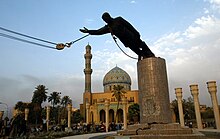
Saddam Hussein Abd al-Majid al-Tikriti was an Iraqi politician and revolutionary who served as the fifth president of Iraq from 1979 to 2003. He also served as prime minister of Iraq from 1979 to 1991 and later from 1994 to 2003. He was a leading member of the revolutionary Arab Socialist Ba'ath Party, and later, the Baghdad-based Ba'ath Party and its regional organization, the Iraqi Ba'ath Party, which espoused Ba'athism, a mix of Arab nationalism and Arab socialism.
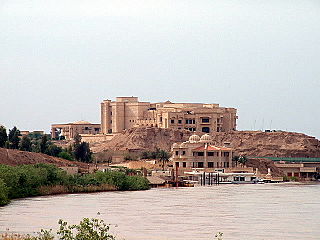
Tikrit is a city in Iraq, located 140 kilometers (87 mi) northwest of Baghdad and 220 kilometers (140 mi) southeast of Mosul on the Tigris River. It is the administrative center of the Saladin Governorate. As of 2012, it had a population of approximately 160,000.

The Battle of Baghdad, also known as the Fall of Baghdad, was a military engagement that took place in Baghdad in early April 2003, as part of the invasion of Iraq.

The 2003 invasion of Iraq involved unprecedented U.S. media coverage, especially cable news networks.
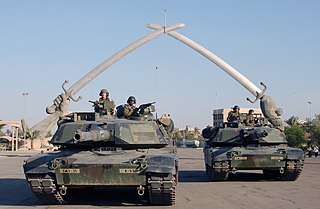
The following is a timeline of major events during the Iraq War, following the 2003 invasion of Iraq.
Events in the year 2004 in Iraq.

After the 2003 invasion of Iraq was completed and the regime of Saddam Hussein was toppled in May 2003, an Iraqi insurgency began that would last until the United States left in 2011. The 2003–2006 phase of the Iraqi insurgency lasted until early 2006, when it escalated from an insurgency to a Sunni-Shia civil war, which became the most violent phase of the Iraq War.
Events in the year 2005 in Iraq.

Al-Firdos Square is a public open space in central Baghdad, Iraq. It is named after the Persian word Ferdows, which means "paradise". The site has been the location of several monumental artworks.
Jack Coughlin is a retired United States Marine Corps Gunnery sergeant and the author of the autobiography Shooter.

The 2004 Iraq spring fighting was a series of operational offensives and various major engagements during the Iraq War. It was a turning point in the war; the Spring Fighting marked the entrance into the conflict of militias and religiously based militant Iraqi groups, such as the Shi'a Mahdi Army.

The Monument to the Unknown Soldier is a monument in central Baghdad built by Italian architect Marcello D'Olivo based on a concept by Iraqi sculptor Khaled al-Rahal and constructed between 1979 and 1982. It was dedicated to the martyrs of the Iran–Iraq War. In 1986 the national square of Iraq, Great Celebrations square, was built near the monument, and two other monuments were built close to the square in memory of the martyrs. In 1983, the Al-Shaheed Monument on the River, was opened and in 1989 the newly built Victory Arch became the entrances to the square. The Unknown Soldier's Monument represents a traditional shield (dira'a) dropping from the dying grasp of an Iraqi warrior. The monument also houses an underground museum.
Kadhem Sharif al-Jabouri is an Iraqi wrestler and weightlifter. He attempted to use a sledgehammer to bring down the statue of Saddam Hussein at the Firdos Square in Baghdad.
Bassem Hamad al-Dawiri was an Iraqi sculptor and artist. He helped create a Baghdad artist association, called the "Survivors' Group" following the fall of the Saddam Hussein government in 2003.

Ba'athist Iraq, officially the Iraqi Republic (1968–1992) and later the Republic of Iraq (1992–2003), was the Iraqi state between 1968 and 2003 under the rule of the Arab Socialist Ba'ath Party. This period began with high economic growth, but ended with the country facing severe levels of socio-political isolation and economic stagnation. By the late 1990s, the average annual income had decreased drastically due to a combination of external and internal factors. UNSC sanctions against Iraq, in particular, were widely criticized for negatively impacting the country's quality of life, prompting the establishment of the Oil-for-Food Programme. The Ba'athist period formally came to an end with the 2003 invasion of Iraq, and the Ba'ath Party has since been indefinitely banned across the country.
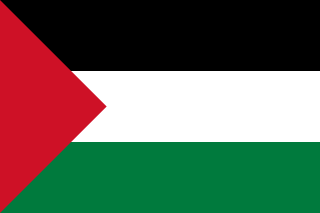
The Arab Socialist Ba'ath Party – Iraq Region, officially the Iraqi Regional Branch, is an Iraqi Ba'athist political party founded in 1951 by Fuad al-Rikabi. It was the Iraqi regional branch of the original Ba'ath Party, before changing its allegiance to the Iraqi-dominated Ba'ath movement following the 1966 split within the original party. The party was officially banned following the American invasion of Iraq in 2003, but despite this it still continues to function underground.
Abdullah Sallum al-Samarra'i was an Iraqi Ba'athist politician and leading member of the Arab Socialist Ba'ath Party in Iraq. He was a member of the Regional Command from 1964 to 1970, when he was expelled.
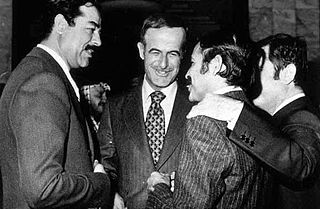
The 1979 Ba'ath Party Purge or Comrades Massacre was a public purge of the Iraqi Ba'ath Party orchestrated on 22 July 1979 by then-president Saddam Hussein six days after his arrival to the presidency of the Iraqi Republic on 16 July 1979.

The 17th of Ramadan Mosque is a mosque in al-Rusafa, Baghdad, in the eastern Karrada district, opposite al-Firdos Square, in front of the Ishtar Hotel. The mosque dates back to the royal era of Iraq and is considered an important historical landmark since it's located in a significant square in the city.

Al-Sa'doun Street or al-Sa'adoun Street is one of the main streets Baghdad, Iraq, which connects the districts of al-Rusafa and eastern Karrada and located in al-Sa'doun neighborhood. The street runs from al-Tahrir Square to the Kahramana Square where the Kahramana monument is located with al-Firdos Square located in the middle of it which contains the 17th of Ramadan Mosque, the Palestine Hotel and the Ishtar Hotel. The street was also notable for including many cinemas, cafés, libraries, and shops.
